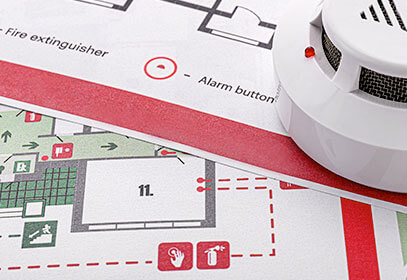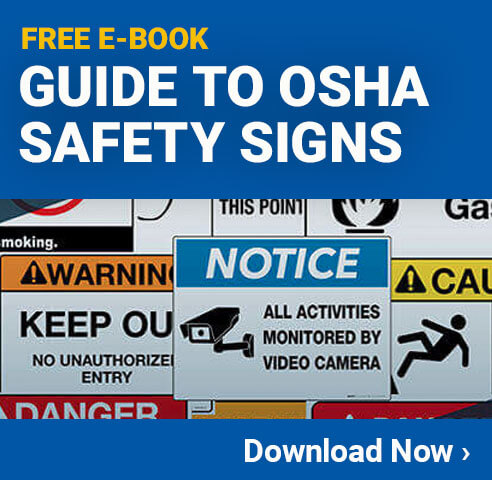Resources
Emergencies can strike anytime and anywhere, causing your business to evacuate in a moment’s notice. Is your facility prepared? A disorganized evacuation can be chaotic, resulting in confusion, injury, or property damage. The best way an organization can protect themselves in an emergency is by being adequately prepared to respond.
You should first consider what kind of potential emergencies could hit your facility. What toxic chemicals are being stored? Is the region known for flash floods? Are there any fire hazards that have yet to be addressed? Identify the sources of these emergencies, think about worst-case scenarios, brainstorm how you and your employees would respond.
There are several components to planning for emergency evacuation, such as:
- Emergency Action Plans: OSHA strongly recommends organizations have a documented EAP with an evacuation policy and designated employee roles. An EAP should also include route assignments and escape procedures on floor plans or maps.
- Safety Signs: In an emergency, people panic and can easily forget where exits or emergency supplies are. Post easy-to-read safety signs directing people to first aid kits or evacuation routes as a helpful reminder.
- Photoluminescent/Glow-in-the-dark tape: For a lights-out emergency, use glow-in-the-dark tape to create exit routes that will glow brightly for several hours. You can also find floor tape, signs, and even handrail tape made from the same glowing material.
As the leaders in visual safety, Creative Safety Supply strives to help companies create compliant spaces that are safe to work in. Browse our expert resources about emergency evacuation, regulations, and solutions below!
Getting Started
- Don't know where to start? Find out what labels you need with the pipe marking calculator.
- Want to learn more about facility marking? Explore our labeling resources.
- Have a question about pipe labeling? Browse our pipe marking Q&A hub.
- Ready to get started? Shop our selection of pipe marking supplies.
Emergency Evacuation Articles
Preparing the Workplace with Emergency Action Plans (EAP)
An emergency action plan is a written document required by OSHA that details procedures carried out by employees during the event of an emergency. …
Food Security
With the 2011 passage of the Food Safety Modernization Act, considerable attention has been focused on the purity of our foods from the perspective of accidental contamination. …
Floor Marking Ideas for Warehouses
Warehouse floors provide an opportunity for visual communication. Find out what floor signs, tapes, and shapes you can use. …
Floor marking comprehensive research, education and training
Everything you need to know about marking your facility’s floors. Types of markings, practical tips, and more. …
Emergency Evacuation Questions and Answers
What should emergency action plan (EAP) include?
An emergency action plan, or EAP, exists to prepare employees for emergencies ranging from ones originating outside of the building such as natural disaster threats, emergencies within the building such as power outages or fires, and health-related emergencies such as heart attacks or concussions. Due to the nature of these dire situations, OSHA has implemented regulations… …
Where are emergency exit signs required?
Emergency exit signs, often glowing green or red, are necessary for most every building. Exit sign requirements often go hand in hand with OSHA’s regulations regarding emergency evacuation routes and their three parts; Exit access, exit, and exit discharge. OSHA’s exit sign regulations can be found in 29 CFR 1910.37 “Exit Routes and Emergency Planning.”… …
What should an evacuation plan include?
At the bare minimum, there are six main components that must be in an evacuation plan according to OSHA. With these, the employer will be able to better prepare employees for emergency situations that may arise in the workplace, they are: A way of reporting emergencies Evacuation procedures and emergency escape route assignments Procedures for… …
What is it important to have an evacuation plan in place?
The need for an emergency evacuation can occur at any time. There are numerous types of events that can instigate an evacuation, some include weather related events such as hurricanes, floods, and fires, or human caused emergency situations involving civil disturbances, chemical spills, and explosions. Unplanned events like these do not allow time for employees… …
What is an emergency evacuation plan?
An emergency evacuation plan aims to prepare employees with information that enables them to evacuate a building as quickly and safely as possible. These plans must cover all relevant scenarios of possible emergencies for employees to be sufficiently prepared. Emergency situations can include anything from natural disasters, industrial accidents, transportation accidents, military attacks, structural failure,… …
What are fire code egress requirements?
Fire code requirements vary wildly from building to building depending on the location, size, and type of work being performed. Those requirements can be found within the NFPA’s Life Safety 101 code. However, naming all the requirements is quite extensive, so this post will only go over the rules that are applicable to most all… …
When does OSHA require an emergency response?
There are several factors that must be considered before determining how to proceed during a possible emergency situation. Those elements include: The nature of the emergency The degree of the emergency The size of the organization The capability of the organization in an emergency situation The ability to request outside aid The physical layout of… …
What are the clearance requirements for emergency exits?
Emergency exits, or egress routes as many may know them by, have set clearance requirements to ensure building occupants have enough space to safely exit the building. The following dimensions help with creating a consistent environment for employees and have been proven to assist in meeting the most optimal emergency evacuation needs. What is egress? Egress capacity… …
What emergency response procedures does OSHA require?
Emergency response procedures vary wildly across businesses depending on what they do, where they are located, and the materials within the building. For that reason, developing a unique emergency response procedure is absolutely necessary to protect both workers and property at that site. Training is at the front and center of any emergency plan as employees… …
What are the safety sign requirements for emergency evacuation signs?
Employers must follow safety sign requirements that come from OSHA and any local building code requirements that the state or county may have. Currently, the only evacuation signs that OSHA actively requires are that of exit signs. 29 CFR 1910.37 describes lighting and marking requirements for emergency exit signs to maximize visibility and the ability… …
Are emergency evacuation drills required by OSHA?
OSHA’s document titled How to Plan for Workplace Emergencies and Evacuations specifically states: “Once you have reviewed your emergency action plan with your employees and everyone has had the proper training, it is a good idea to hold practice drills as often as necessary to keep employees prepared.” As can be seen here, OSHA does… …
Are emergency evacuation maps required?
OSHA mentions that employers are required to have emergency escape procedures and route assignments, however, it does not specifically require employers to have printed and posted evacuation maps inside a building. Instead, OSHA takes a more benevolent stance by not directly saying that employers must provide them, but rather hints that they strongly recommend them. On… …
What are exit routes?
An exit route, as defined by OSHA, is a continuous and unobstructed path of exit from any point within a facility to somewhere safe. Exit routs consist of three separate parts: An exit access is the section of the route that directly leads to an exit. The exit is separated from all other areas to… …
What should be in an evacuation kit?
Emergency conditions have the ability to strike the workplace at any time which is why it’s so important to stay at least one step ahead. For that reason, creating an evacuation kit or emergency kit is a great way to prepare for natural disasters or human caused emergency situations. These types of kits have the potential… …
What are emergency evacuation processes?
Knowing a building’s unique emergency evacuation process is essential to be prepared for an emergency situation. Emergency conditions have the ability to strike anytime and are either caused by internal threats within the building or external threats stemming from events outside of the employees’ control. For that reason, being prepared for an emergency at all… …
What is an evacuation assembly area?
Accounting for all employees after an evacuation can be difficult if they aren’t all gathered in one place. For that reason, designated assembly areas are an essential part of every evacuation plan. These areas are often referred to “areas of refuge” and can be located inside or outside of the building depending on the type… …
What are OSHA requirements for emergency evacuation?
There are several requirements that must be followed regarding emergency evacuation plans. Put in place by OSHA, these regulations work to ensure the safety of building occupants by preparing them for worst-case scenarios. Compliance with OSHA’s 29 CFR 1910.38 will not only improve workplace safety and save lives in an emergency, it will also help… …
Where should emergency evacuation maps be posted?
Evacuation maps, just like any other visual communication tool, should be placed in areas that catch the eyes of employees to remind them of emergency evacuation protocols. They should be in areas where emergency exits are not readily apparent and in well-lit spaces for employees to be able to see the map. It also might… …
What is an EAP?
EAP stands for, “Emergency Action Plan,” and is a document that a facility has to develop to show the actions that people must take in the event of an emergency. The EAP is required by OSHA for most types of facilities. The specific contents of an EAP will depend on the area for which it… …
What does EAP stand for?
EAP is an abbreviation for Emergency Action Plan. These plans are an integral component to safety procedures and help coordinate actions that take place in response to an emergency in the workplace. EAPs designate responsibilities to specific employees so there is no disorganization, injury, or property damage during an emergency and instead a safe response… …
What does egress mean?
The word egress refers to the act of, or a path to, come out of an area. Having an egress from a building means that there is a way to exit it the building. This is an important topic when designing a workplace, planning safety procedures, or creating an emergency action plan (EAP). Understanding where… …











